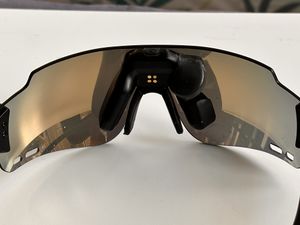ActiveLook Smart Glasses
From Fellrnr.com, Running tips
Revision as of 02:35, 24 May 2024 by User:Fellrnr (User talk:Fellrnr | contribs)
I love having a heads-up display, and while my previous Solos Smart Glasses worked, they had too many flaws. So, I brought a pair of Engo-2 smart glasses, which use the ActiveLook OLED display. The display is bounced off the inside of the glasses into your eyes, so it appears to float in front of you. Like most technology, there are pros and cons to these glasses, but I think they are well worth it for interval training or racing.
1 The Good
- Having a constant display of data is awesome for interval training. When running hard, you can't keep looking at your watch. It's a similar story when racing, we're having a continual display of your data helps keep you on track.
- You can have up to 6 data fields displayed at one time. You can also swipe your hand just above the bridge of the glasses to swap between pages of data. The glasses support a wide variety of data fields, covering everything most people are likely to want, including Stryd. For interval training, I like to see how much of the interval is left, how my current effort compares with the goal, and how I'm responding. Most of my intervals use distance rather than time, but I have two pages of data, one showing the time and the other showing the distance elapsed.
- The glasses support Garmin running dynamics, so you can see stride length, vertical oscillation, ground contact time, et cetera. If you're trying to improve your running form using running dynamics, then a heads-up display is ideal. After all, looking at your watch disrupts your running form.
- The system integrates with most popular watches, and the Garmin Connect IQ dataData field has been open sourced, so if you have the skill set, you can change the behaviour. I added support for RunScribe, which provides a lot more detailed analysis of running biomechanics. There's no need to run with a smartphone, though there is an app you can use.
- I found the display easy to read, unlike my other head up display glasses. It's bright enough to read in bright sunlight, though I often wear a baseball cap with the display positioned so it's looking like it's part of the bill of the cap.
- The heads-up display is made by a separate company from the glasses. This means there are various glasses available from different manufacturers, including Julbo. I think this creates a more viable ecosystem that is more likely to be supported in the long term.
- The Engo-2 are $299/€299, which I think is good value, with the photochromic version another $/€50 (a worthwhile upgrade). The Julbo EVAD-1 are €500. The "enterprise" version with clear lenses is €250.
2 The Bad
- The biggest downside to these glasses is there's an electronics bulge on the nose piece. If you put your thumb along the right side of your nose and your first finger along the left side of your nose, you'll get a fairly good impression of how it interferes with your vision. You can still see everything, but the centre of your vision is now only through one eye. You get used to this after awhile, but it still creates a little bit of eyestrain. The bigger issue is you've lost depth perception in the centre, which puts me off using these on any kind of technical trail. Even non-technical trails where you might have rocks to avoid might be dodgy.
- The battery life is okay for most people but wouldn't support ultrarunning. You can't charge the glasses while you're wearing them.
- Unlike many other expensive sunglasses, these don't have interchangeable lenses. You can now get them with photochromic lenses, which I'd recommend over the dark glasses I have.
